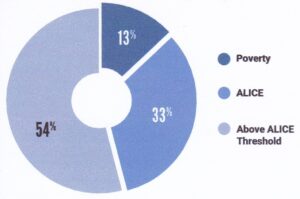By William Coty Keller, Ph.D.
Before the pandemic, in spite of growing GDP, stock market highs and low unemployment, almost half American families were in bad shape financially.
Plus, we were doing nothing to avert the climate crisis. Let’s not return to that scenario. Instead, we need a recovery that solves both these problems.
United Way reports that when COVID-19 hit, nearly 2.6 million Florida households were considered ALICE (Asset Limited, Income Constrained, Employed) — unable to afford the basics for survival even though they were working. When we add in one million families that were in poverty, 46% of Florida’s 7.8 million households were in a dire financial situation before the pandemic.

Meanwhile, we were experiencing more extreme weather, wild fires, droughts and floods. What lies ahead is even more frightening. The Union of Concerned Scientists predicts that parts of Florida will become miserable, if not unlivable, with killer heat.
As the UN panel on climate reported, “Absent radical changes in energy policy and human behavior, we should expect severe economic and humanitarian crises by as early as 2030.”
What can we do to recover? Here are four steps:
Change Economic Measures of Success.
The Positive Money people remind us that GDP does not enhance life satisfaction, alleviate poverty, or protect the environment. We should focus on more relevant indicators such as a life expectancy, a living wage, the amount of carbon dioxide in the atmosphere, and education. By measuring and aiming for the right things we will have a better chance of achieving an effective and just recovery from the pandemic.
Abolish corporate personhood.
There will be no economic and climate justice while corporations and the rich have disproportionate influence in government.
We must amend the Constitution by declaring that corporations are not people and money is not free speech. The We The People Amendment does two things: Only human persons will have constitutional rights. And it requires regulation, limitation, or prohibition of campaign spending.
Convert from fossil fuels to zero emission energy.
Recent work by Rewiring America and Energy Innovation makes clear that achieving the transition is technically achievable and economically beneficial. Zero emission infrastructure investments, and the millions of good paying jobs created in the conversion, are what make the recovery such an economic success.

Plus, this results in billions of health dollars saved – think no more smokestacks and tail pipes polluting our air and lungs. Because of the daunting scope and timing required to keep global average temperatures below the thresholds cited by the UN IPCC there is no time to waste.
We must make about 8% per year reductions in greenhouse gas emissions, replacing 70-100% of fossil fuel energy with zero emission sources by 2030.
The Union of Concerned Scientists has told us what needs to be done in terms of the policies to be enacted by the various levels of government: At the federal level, a price on carbon with all revenues returned to households and global cooperation which, at a minimum, will carry out the Paris Agreement; at the state level, mandating portfolio standards that achieve 100% zero emission electrical energy by 2030, and regulation of utilities so that they practice real energy conservation; at the local level, rules for net zero energy buildings, transportation and landscapes.
Reforestation and soil management.
Cutting emissions from fossil fuels is half of the solution. Removing carbon already in the atmosphere is the other half.
Planting lots of trees, as explained in National Geographic, can erase 100 years of emissions. A modern-day version of the depression-era Civilian Conservation Corps (CCC) could put millions of unemployed young people to work.
Meanwhile managing our soils to better store carbon through regenerative agriculture would replenish the soil’s nutrients without relying on synthetic and mined fertilizers.
As described by Mother Jones in Paying Farmers to Store Carbon, these practices not only mitigate climate change but make for good-paying jobs. Farmers earn more profit on every acre because they spend less on equipment, water, herbicides, and synthetic fertilizer.
Other benefits of carbon farming are increasing the soil’s ability to hold water and protect against erosion.
Let’s support policies that sequester carbon such as the House Democrats’ Climate Crisis Action Plan, which dedicates a chapter to investing in agriculture as a climate solution. In his Plan for Rural America, presidential candidate Joe Biden promises to make the United States’ agricultural sector the first in the world to achieve “net-zero” emissions, in part by increasing payments to farmers for carbon farming.
Let’s abandon any ambitions to return to the pre-COVID 19 status quo. Let’s instead set our sights on a recovery that is effective (in that it will provide good-paying jobs and eliminate the cause of global warming) and that is just (it will benefit all Americans).
William “Coty” Keller is an ecologist, working to conserve and restore the natural relationships among living things and the environment. He lives and works in Port Charlotte. https://ecopapak.org/
This was first published in Fall 2020 edition of Critical Times
“The Invading Sea” is the opinion arm of the Florida Climate Reporting Network, a collaborative of news organizations across the state focusing on the threats posed by the warming climate.




Coty hits all the bases with informed and validated points, is realistic, not alarmist and easy to understand. I’m sold!